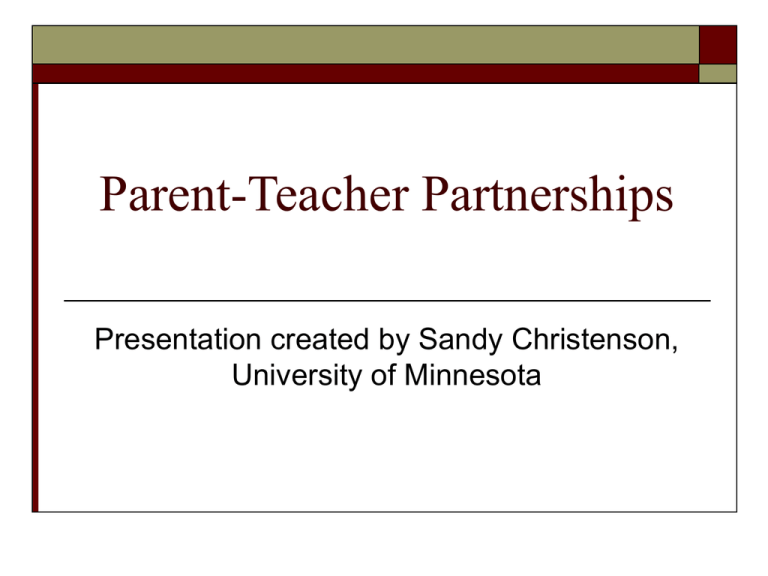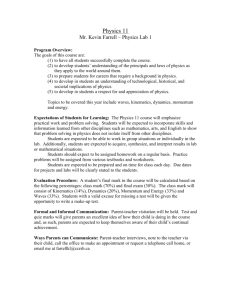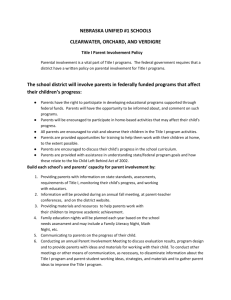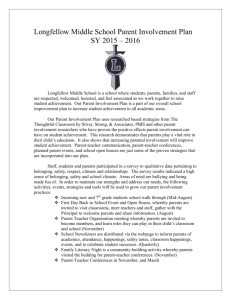Parent-Teacher Partnerships
advertisement

Parent-Teacher Partnerships Presentation created by Sandy Christenson, University of Minnesota Parent-Teacher Partnerships Goals: To provide a broad overview of a process for creating constructive parent-teacher partnerships. To provide selected findings and sample practices. Module is filled with information and 14 study group activities from which to select Consider me a resource to address concerns for your school context Four A’s: A Guide to Develop Parent-Teacher Partnerships Approach: Attitudes: Atmosphere: Actions: The framework for interaction with parents The values and perceptions held about parent-teacher relationships The climate for parent-teacher interactions Strategies for building shared responsibility for students’ reading progress and success Approach Think of students in your class last year – those who were readers and those who struggled. On a scale of 1-10, how important, in your experience, is family engagement with learning to students’ reading success? Hart and Risley’s Study Observed parent-child interaction in 42 families who differed in terms of income They found: Children in professional families heard, on average, 2,150 words per hour, whereas children in working class (1,250) and welfare (620) families were exposed to many less words. The cumulative language experience for children by age 3 differed in amount and kind, and these differences were highly correlated with children’s reading/language performance at ages 9-10. Entwisle and Alexander’s Study Followed kindergarten children in the Baltimore Schools They found: Low income children made comparable grade equivalent gains in reading and math during the school year as do middle income children. Differences were due to experiential learning and home resources during the summer. The gap widened across school years due to the differential effect of out-of-school learning. Ask yourself: How do families help you do your job better? Be more successful in reaching your goals? How do you think of the roles parents and teachers’ play relative to students’ becoming readers? M & M’s: Creating a Successful Learning Environment Be a good role model. Motivate your child. Monitor your child’s performance. Maintain contact with teachers. A host of research findings. . . Student benefits: grades, test scores, attitudes toward schoolwork, behavior, academic perseverance, homework completion, attendance What parents do to support learning predicts scholastic ability better than who families are. Creating consistent messages about learning across home and school helps increase the probability students will perform their best. Parents and Teachers as “Partners” A student-focused philosophy – collaborate for the learning progress of the student A belief in shared responsibility – both in-and out-ofschool time impacts achievement Quality of the relationship – how parent and teacher work together in meaningful ways A preventive, solution-oriented focus – create conditions that encourage and support student’s reading and engagement Attitudes Dialogue Time: What is the role of attitudes in productive family-school connections? (Right side of room) - What teacher attitudes help build constructive relationships with parents? (Left side of room) - What parent attitudes help build constructive relationships with teachers? Collaboration is evident when parents and teachers: Listen to one another’s perspective. View differences as strengths. Focus on mutual interests. Share information to co-construct understandings. Respect the skills and knowledge of each other by asking for opinions and ideas. Plan together and make decisions that address the needs of parents, teachers, and students. Refrain from finding fault – no problematic individuals; rather a problematic situation that requires our attention. Celebrate “our” successes. New Beliefs and Principles about Families Help Foster Relationships All families have strengths, and their assets, not deficits, are emphasized. Parents can learn ways to help their children if they are provided with the opportunity and necessary support. Parents have important information and perspectives about their children that are needed by teachers. Schools and families influence each other. A no-fault, problem solving model is necessary – blame is not attributed to the family or school because there is not a single cause for any presenting concerns. A challenge facing teachers. . . “It is the school’s job. I don’t have time.” Strategies for helping parents make education a priority in the home are emerging: Deliver a persistent message about the importance of in and outof-school time Keep and sustain a focus on the salience of education – find a feasible way for all families to be engaged in supporting their children’s reading. Emphasize both academic and motivational home support for learning. Families do not need to be fixed; they need to be supported. Atmosphere Pretend you have an index card. Write one thing that helps parents feel welcome at school. If I collected the cards and sorted them into one of six categories: Communication Trust Quality of relationship with teacher Problem solving orientation Physical appearance Other Where does your idea best fall? Of 27 choices, the “top 10” were: Experience when talking with their child’s teacher The relationship between their child and his/her teacher Meetings with school personnel to address concerns Overall “feeling” in their child’s class Overall “feeling” in their child’s school Relationship between families and teachers at the school Parent-teacher conferences Cleanliness of the school Initial contact when families first enter the school How differences of opinion or conflict are handled Power of Solution-oriented Language Expressing concerns must invite parental input “I am concerned about how little work Tess is doing” vs. “I’m not at all pleased with Tess’s progress.” Communication must: Help parents view their children as learners, Enhance parental beliefs that they can be helpful and make a difference, and Enhance parents’ comfort level at schools and with educational issues. Initial Phone Call about a Concern Begin with a statement of concern. Describe the specific behavior that necessitated the call. Describe the steps you have taken to solve the concern Get parental input. Present your plan to the parent. Express concern in our ability to solve the concern. Inform parents about follow-up contact from you. Canter & Canter, 1991 Actions Approach, attitudes, and atmosphere are the “backdrop” for the actions to be taken to develop shared responsibility for children’s reading progress. Approach – Parents are essential Attitudes – Equality, parity, and perspective taking (golden rule counts!) Atmosphere – How can we work together to address a concern or shared goal? Actions are different than activities Actions to Enhance Home Support for Learning 11 actions are provided as guidelines or a template for creating a home support for reading program. Apply literature on effective parent-teacher partnerships and draws from STARS: Sit Together and Read Something (Christenson, 2001). Modify to fit your school context! Action 1 Be proactive! Reach out and make a friendly, positive introductory contact before any specific reading or student concern arises. “Before School Starts” Greeting Goal Setting and Positive School Message Sharing Student Talents (STAR Talent) Goal Setting and Positive School Message Individually or at orientation night Share goals for the child’s performance: Teacher, Parent(s), and Student. Note consensus. Ask parents to provide children with an important message: Your teacher cares about you and believes I am important for helping you to learn to read. We have agreed to work together to make this a great school year. Establish a way to contact each other. Action 2 Invite parents to partner and explain the conditions under which learning to read is most optimal for students. • • • • STARS Invitation Obtain parental input on how to create a “reading star” Reading Success = Reading in School + Reading at Home + Parent-Teacher communication Partnership for Children’s Reading (school wide) Action 3 Create a plan for home support for reading. Offer parents the opportunity to react to and modify the plan to fit their situation. • • • • Name your reading effort/program. Use the empirical base in reading to design varied options for parents (shared book reading, vocabulary development, phonics). Design simple, routine activities. Goal is to involve all parents in some way. Action 4 Consider holding a curriculum night where students present the evidence based reading practices. • • • Students demonstrate what parent and child would do together. Attendance is higher when students are featured, sessions are offered at multiple times, daycare and transportation are offered, and importance is linked to children’s learning. Home visits for non-attendees. Action 5 Consider creating a “success for all” approach – or classroom goal on reading and an atmosphere that celebrates students’ reading improvement and progress. • • • • Set individual student goals Use parent-teacher-student partnership agreements Place students “in charge” to complete home activities Establish class goals based on overall improvement, followed by rewards Action 6 Allow parents to make modifications and/or select from several options for the home support for reading program. • • • • Majority use standard program Modify for unique situations Value is persistence - always deliver a non-blaming message that out-of-school reading time influences children’s reading progress Key: Expect participation but do not mandate how Action 7 As the program is implemented, maintain a focus on the progress and performance of the child when communicating with the parent. • • • • Good news phone calls/ STARS postcards Contact parent at the first sign of a concern Meet to re-plan: “I am concerned about Erica’s reading progress. Let’s decide what else we can do, as I know Erica can make faster progress.” Consider including the student in the meeting. Action 8 Maintain relationships with parents through two-way communication. Provide information and obtain their feedback about how your reading effort is working. • • Provide progress reports on a regular basis (4-6 week assessments) “Please let me hear your ideas. It is with your help that I can make this classroom the best learning environment for Dewan.” Action 9 Maintain a check on your attitudes especially if parents are not implementing the program. • • Portray attitudes that are encouraging – I know we can solve this together. I know we can find a reasonable way for Tarnika to get extra reading time outside of school.” Problem solve with parents – who is the designated surrogate? Action 10 Strive for a standardized reading effort, but also employ “extras” for unique situations. • • • Modify home activities Provide specific resources Find a role for each parent – academic or motivational support Action 11 Be realistic. • • Quandary: Some families believe they have very little to contribute to their children’s reading and learning. Key: Control what we as educators can: • Convey a persistent message. • Keep interaction focused on a genuine interest in improving the child’s reading. • Link parents’ efforts to their goals for their child. • Make regular, ongoing contact with parents, providing friendly reminders. Additional Information and Support 79 page module on the web Leadership Team Contact information: Sandy Christenson, School Psychology Program, 75 East River Road, 350 Elliott Hall, Minneapolis, MN 55455 phone: 612 624-0037 fax: 612 624-0879 chris002@umn.edu







